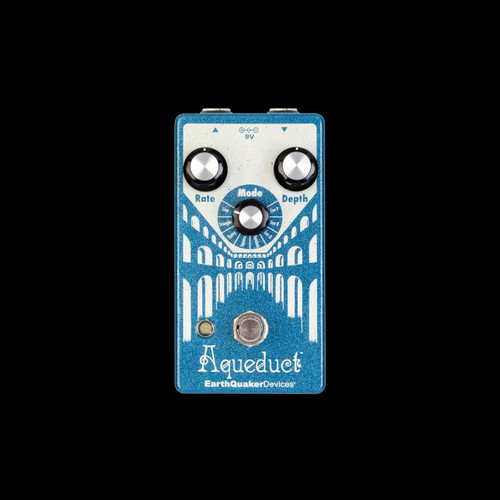
Picture Is A Stock Photo!
Earthquaker Devices Aqueduct Vibrato Pedal
Welcome to your new EarthQuaker Devices Aqueduct Vibrato!
Contrary to what’s written on the faceplate of certain famous deluxe amplifiers, Vibrato is a form of frequency (or wavelength) modulation which we hear as a variation in pitch. It is often confused with Tremolo, which among other things, is a type of amplitude modulation our ears hear as a change in volume.
Aqueduct uses a short delay line with eight different modulation modes to deliver gentle rolling pitch-wobbles, steady kosmiche pulsations, rapid trills, slimy sonic squiggles, whammy bar wiggles, and anything else your pitch-warped brain can picture in your murky mind’s eye.
The controls are simple. Rate (1) adjusts the LFO speed which controls how quickly the pitch rises and falls. Depth (2) controls the LFO amplitude, adjusting the intensity of the vibrato effect. The rotary switch labeled Mode (3) selects between one of eight LFO waveshape and envelope combinations which drastically alter the character of the modulation and make Aqueduct adaptable to nearly any musical situation.
This is the portion of the manual where we list Aqueduct’s eight modes in order from “not that weird” to “wow, that’s weird.” Here we go:
- Sine: The smoothest and most subtle of all waveforms, sine waves are most commonly associated with classic amp-like vibrato. Plug in, turn on, and commence the Chooglin’.
- Triangle: Triangle waves have a sharper rise and fall than sine waves with a more pronounced pitch bend at the peak of each LFO cycle.
- Ramp: Like a triangle wave with a twist. The Ramp waveform has a sharp sonar pulse followed by a rapid downward slope with a synthesizer-like sustain and release. This is where things start to get a little weird.
- Square: Square waves are the most rigid and abrupt of the waveforms. Rather than gliding smoothly between pitches, square waves produce an instant on-or-off transition between notes. Use this mode for trills when you get tired of doing hammer-ons and pull-offs.
- Random: This waveform isn’t a waveform at all as much as it’s a drunken master of modulation who slurs your notes into an unpredictable assortment of greasy pitch-bends before disappearing at last call and leaving you stuck with the tab. It has a “warped record” effect at low Depth settings and becomes sloppier and more randomized as you increase the Depth control.
- Env D: This is Envelope-Controlled Depth mode. The waveshape is set to a sine wave, the speed of which may be adjusted using the Rate control. The Depth control sets the sensitivity of the envelope - the point at which the effect kicks in as you play. In this mode, your pick attack sets the intensity of the modulation. The harder you dig in, the more pronounced the effect. Try it during your next motorik jam.
- Env R: This is Envelope-Controlled Rate mode. In this mode, the input level (i.e. pick attack) controls the LFO rate. The LFO uses a sine waveshape. Play harder for faster modulation or lay low for slower modulation speeds. The Rate control adjusts the sensitivity of the envelope. Depth selects the LFO intensity.
- Env P: This is Envelope-Controlled Pitch mode, which we’ve lovingly nicknamed “The My Bloody Valentine setting.” If your instrument doesn’t have a tremolo bar, it does now. In this mode, the LFO is set to a sine waveshape, and frequency modulation is controlled by the dynamics of your pick attack and not the LFO. Do yourself a favor and try this one with Flexi-Switching™.
- Depth sets the wet/dry mix. This is the only mode that contains a wet/dry mix and may be set to taste to create touch-sensitive dynamic vibrato, chorus, flanger, or tactile pitch drops. Full counterclockwise is all dry, full clockwise is all wet. With this control set to noon you will get a 50/50 mix with a small amount of phase cancellation.
- Rate sets the sensitivity and overall range of the pitch bend.
Pro Tip:
When using any of the envelope modes, we recommend placing the Aqueduct first in the signal chain and/or before any effects that increase volume or gain. The Aqueduct was designed for low to medium output pickups. Any increase in output will make the envelope settings more responsive at lower settings thus making them less dynamic.
Flexi-Switching™
This device features Flexi-Switch™ Technology! This relay-based, true bypass switching style allows you to simultaneously use momentary and latching-style switching.
• For standard latching operation, tap the footswitch once to activate the effect and then tap again to bypass.
• For momentary operation, hold the footswitch down for as long as you’d like to use the effect. Once you release the switch the effect will be bypassed.
Since the switching is relay based, it requires power to pass signal.
Power
This Device should be powered by a standard 9-volt DC power supply with a 2.1mm negative center barrel. We always recommend pedal-specific, transformer-isolated wall-wart power supplies or multiple isolated-output supplies. Pedals will make extra noise if there is ripple or unclean power. Switching-type power supplies, daisy chains and non-pedal specific power supplies do not filter dirty power as well and let through unwanted noise. Do not run at higher voltages!
Warranty
This Device has a limited lifetime warranty. If it breaks, we will fix it. Should you encounter any issues, please email info@earthquakerdevices.com.
|
Current Draw: |
|
68mA |
|
Input Impedance: |
|
1M Ohms |
|
Output Impedance: |
|
<10K Ohms |





